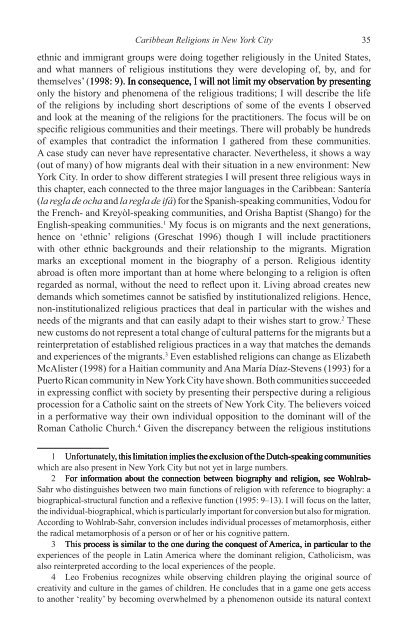Create successful ePaper yourself
Turn your PDF publications into a flip-book with our unique Google optimized e-Paper software.
<strong>Caribbean</strong> <strong>Religions</strong> <strong>in</strong> <strong>New</strong> <strong>York</strong> <strong>City</strong> 35<br />
ethnic and immigrant groups were do<strong>in</strong>g toge<strong>the</strong>r religiously <strong>in</strong> <strong>the</strong> United States,<br />
and what manners <strong>of</strong> religious <strong>in</strong>stitutions <strong>the</strong>y were develop<strong>in</strong>g <strong>of</strong>, by, and for<br />
<strong>the</strong>mselves’ (1998: 9). In consequence, I will not limit my observation by present<strong>in</strong>g<br />
only <strong>the</strong> history and phenomena <strong>of</strong> <strong>the</strong> religious traditions; I will describe <strong>the</strong> life<br />
<strong>of</strong> <strong>the</strong> religions by <strong>in</strong>clud<strong>in</strong>g short descriptions <strong>of</strong> some <strong>of</strong> <strong>the</strong> events I observed<br />
and look at <strong>the</strong> mean<strong>in</strong>g <strong>of</strong> <strong>the</strong> religions for <strong>the</strong> practitioners. The focus will be on<br />
specific religious communities and <strong>the</strong>ir meet<strong>in</strong>gs. There will probably be hundreds<br />
<strong>of</strong> examples that contradict <strong>the</strong> <strong>in</strong>formation I ga<strong>the</strong>red from <strong>the</strong>se communities.<br />
A case study can never have representative character. Never<strong>the</strong>less, it shows a way<br />
(out <strong>of</strong> many) <strong>of</strong> how migrants deal with <strong>the</strong>ir situation <strong>in</strong> a new environment: <strong>New</strong><br />
<strong>York</strong> <strong>City</strong>. In order to show different strategies I will present three religious ways <strong>in</strong><br />
this chapter, each connected to <strong>the</strong> three major languages <strong>in</strong> <strong>the</strong> <strong>Caribbean</strong>: Santería<br />
(la regla de ocha and la regla de ifá) for <strong>the</strong> Spanish-speak<strong>in</strong>g communities, Vodou for<br />
<strong>the</strong> French- and Kreyòl-speak<strong>in</strong>g communities, and Orisha Baptist (Shango) for <strong>the</strong><br />
English-speak<strong>in</strong>g communities. 1 My focus is on migrants and <strong>the</strong> next generations,<br />
hence on ‘ethnic’ religions (Greschat 1996) though I will <strong>in</strong>clude practitioners<br />
with o<strong>the</strong>r ethnic backgrounds and <strong>the</strong>ir relationship to <strong>the</strong> migrants. Migration<br />
marks an exceptional moment <strong>in</strong> <strong>the</strong> biography <strong>of</strong> a person. Religious identity<br />
abroad is <strong>of</strong>ten more important than at home where belong<strong>in</strong>g to a religion is <strong>of</strong>ten<br />
regarded as normal, without <strong>the</strong> need to reflect upon it. Liv<strong>in</strong>g abroad creates new<br />
demands which sometimes cannot be satisfied by <strong>in</strong>stitutionalized religions. Hence,<br />
non-<strong>in</strong>stitutionalized religious practices that deal <strong>in</strong> particular with <strong>the</strong> wishes and<br />
needs <strong>of</strong> <strong>the</strong> migrants and that can easily adapt to <strong>the</strong>ir wishes start to grow. 2 These<br />
new customs do not represent a total change <strong>of</strong> cultural patterns for <strong>the</strong> migrants but a<br />
re<strong>in</strong>terpretation <strong>of</strong> established religious practices <strong>in</strong> a way that matches <strong>the</strong> demands<br />
and experiences <strong>of</strong> <strong>the</strong> migrants. 3 Even established religions can change as Elizabeth<br />
McAlister (1998) for a Haitian community and Ana María Díaz-Stevens (1993) for a<br />
Puerto Rican community <strong>in</strong> <strong>New</strong> <strong>York</strong> <strong>City</strong> have shown. Both communities succeeded<br />
<strong>in</strong> express<strong>in</strong>g conflict with society by present<strong>in</strong>g <strong>the</strong>ir perspective dur<strong>in</strong>g a religious<br />
procession for a Catholic sa<strong>in</strong>t on <strong>the</strong> streets <strong>of</strong> <strong>New</strong> <strong>York</strong> <strong>City</strong>. The believers voiced<br />
<strong>in</strong> a performative way <strong>the</strong>ir own <strong>in</strong>dividual opposition to <strong>the</strong> dom<strong>in</strong>ant will <strong>of</strong> <strong>the</strong><br />
Roman Catholic Church. 4 Given <strong>the</strong> discrepancy between <strong>the</strong> religious <strong>in</strong>stitutions<br />
1 Unfortunately, this limitation implies <strong>the</strong> exclusion <strong>of</strong> <strong>the</strong> Dutch-speak<strong>in</strong>g communities<br />
which are also present <strong>in</strong> <strong>New</strong> <strong>York</strong> <strong>City</strong> but not yet <strong>in</strong> large numbers.<br />
2 For <strong>in</strong>formation about <strong>the</strong> connection between biography and religion, see Wohlrab-<br />
Sahr who dist<strong>in</strong>guishes between two ma<strong>in</strong> functions <strong>of</strong> religion with reference to biography: a<br />
biographical-structural function and a reflexive function (1995: 9–13). I will focus on <strong>the</strong> latter,<br />
<strong>the</strong> <strong>in</strong>dividual-biographical, which is particularly important for conversion but also for migration.<br />
Accord<strong>in</strong>g to Wohlrab-Sahr, conversion <strong>in</strong>cludes <strong>in</strong>dividual processes <strong>of</strong> metamorphosis, ei<strong>the</strong>r<br />
<strong>the</strong> radical metamorphosis <strong>of</strong> a person or <strong>of</strong> her or his cognitive pattern.<br />
3 This process is similar to <strong>the</strong> one dur<strong>in</strong>g <strong>the</strong> conquest <strong>of</strong> America, <strong>in</strong> particular to <strong>the</strong><br />
experiences <strong>of</strong> <strong>the</strong> people <strong>in</strong> Lat<strong>in</strong> America where <strong>the</strong> dom<strong>in</strong>ant religion, Catholicism, was<br />
also re<strong>in</strong>terpreted accord<strong>in</strong>g to <strong>the</strong> local experiences <strong>of</strong> <strong>the</strong> people.<br />
4 Leo Frobenius recognizes while observ<strong>in</strong>g children play<strong>in</strong>g <strong>the</strong> orig<strong>in</strong>al source <strong>of</strong><br />
creativity and culture <strong>in</strong> <strong>the</strong> games <strong>of</strong> children. He concludes that <strong>in</strong> a game one gets access<br />
to ano<strong>the</strong>r ‘reality’ by becom<strong>in</strong>g overwhelmed by a phenomenon outside its natural context


















